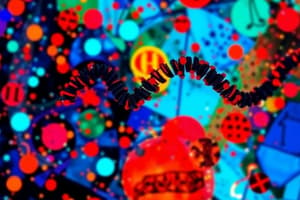Podcast
Questions and Answers
What is the typical size range of a plasmid DNA molecule?
What is the typical size range of a plasmid DNA molecule?
1 to 10 kilobase pairs (kbp)
What is the function of a selectable marker in a plasmid?
What is the function of a selectable marker in a plasmid?
Confer a selective advantage to the host cell
What is the main difference between conjugative and non-conjugative plasmids?
What is the main difference between conjugative and non-conjugative plasmids?
Conjugative plasmids can facilitate the transfer of DNA between bacteria through direct cell-to-cell contact
What is the role of the origin of replication in a plasmid?
What is the role of the origin of replication in a plasmid?
What is one way that plasmid DNA can provide protection to host cells?
What is one way that plasmid DNA can provide protection to host cells?
What is the purpose of a cloning site in a plasmid?
What is the purpose of a cloning site in a plasmid?
Flashcards are hidden until you start studying
Study Notes
Plasmid DNA
Definition
- A small, circular, self-replicating DNA molecule that is separate from the chromosomal DNA
- Found in bacteria and some other microorganisms
Characteristics
- Typically ranges from 1 to 10 kilobase pairs (kbp) in size
- Has a covalently closed, double-stranded circular structure
- Can replicate independently of the host chromosome
- Can be transferred between bacteria through horizontal gene transfer
Components
- Origin of replication: a region where DNA replication is initiated
- Selectable marker: a gene that confers a selective advantage to the host cell, such as antibiotic resistance
- Cloning site: a region where foreign DNA can be inserted
- Plasmid-encoded genes: genes that are not essential for plasmid replication, but can provide additional functions
Types of Plasmid DNA
- Conjugative plasmids: can facilitate the transfer of DNA between bacteria through direct cell-to-cell contact
- Non-conjugative plasmids: cannot facilitate the transfer of DNA between bacteria
- Cryptic plasmids: do not provide a selective advantage to the host cell, but can still be maintained
Functions
- Gene expression: can express genes that are not present on the host chromosome
- Antibiotic resistance: can confer resistance to antibiotics
- Metabolic functions: can provide additional metabolic pathways
- Virus resistance: can provide protection against viral infection
Plasmid DNA
Definition
- Plasmid DNA is a small, circular, self-replicating DNA molecule separate from chromosomal DNA, found in bacteria and some microorganisms.
Characteristics
- Plasmid DNA size ranges from 1 to 10 kilobase pairs (kbp).
- It has a covalently closed, double-stranded circular structure.
- Plasmid DNA can replicate independently of the host chromosome.
- It can be transferred between bacteria through horizontal gene transfer.
Components
Origin of Replication
- The origin of replication is a region where DNA replication is initiated.
Selectable Marker
- A selectable marker is a gene that confers a selective advantage to the host cell, such as antibiotic resistance.
Cloning Site
- A cloning site is a region where foreign DNA can be inserted.
Plasmid-Encoded Genes
- Plasmid-encoded genes are genes that are not essential for plasmid replication but can provide additional functions.
Types of Plasmid DNA
Conjugative Plasmids
- Conjugative plasmids can facilitate the transfer of DNA between bacteria through direct cell-to-cell contact.
Non-Conjugative Plasmids
- Non-conjugative plasmids cannot facilitate the transfer of DNA between bacteria.
Cryptic Plasmids
- Cryptic plasmids do not provide a selective advantage to the host cell but can still be maintained.
Functions
Gene Expression
- Plasmid DNA can express genes that are not present on the host chromosome.
Antibiotic Resistance
- Plasmid DNA can confer resistance to antibiotics.
Metabolic Functions
- Plasmid DNA can provide additional metabolic pathways.
Virus Resistance
- Plasmid DNA can provide protection against viral infection.
Studying That Suits You
Use AI to generate personalized quizzes and flashcards to suit your learning preferences.




